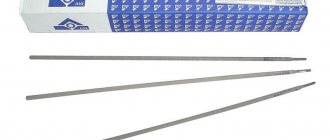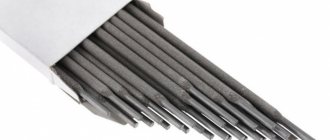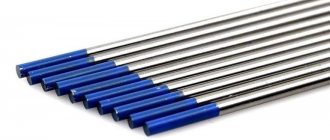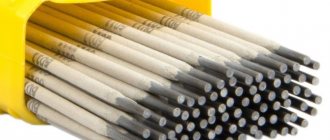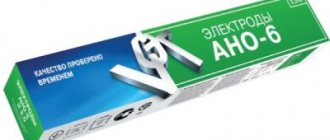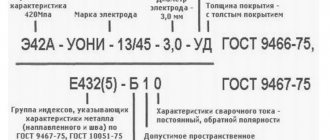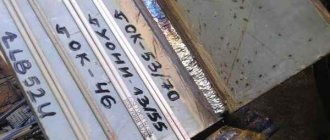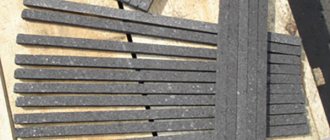Electrodes brand UONI-13/45 – features
The main purpose of the material is welding parts made of low- or medium-carbon steel during the installation of particularly critical structures. Thanks to these electrodes, a seam with increased ductility and impact strength is obtained. The created structures can be used for decades at low temperatures. A typical example is pipelines laid in the northern latitudes of Russia.
High ductility and impact strength of the weld metal are ensured due to the main coating of the rod:
- the coating contains calcium fluoride (CaF2);
- During the welding process, hydrogen, which is harmful to the metal, binds with fluorine into a volatile compound and evaporates from the metal surface.
Thus, the amount of hydrogen in the metal is reduced to a minimum. Thanks to this, hot cracks are eliminated, and the risk of cold cracks (due to hydrogen diffusion) is also practically reduced to zero. Thanks to these same properties, the seam does not crack in a hydrogen sulfide environment. This allows the pipes to be used not only in northern climatic zones, but also in areas where there are deposits with a high content of hydrogen sulfide (oil and gas).
UONI-13/45 (NAKS, RRR, RS) 5 mm (6 kg) Current - constant, reverse polarity
170.28 rub. ? with VAT per 1 kg.
UONI-13/45 (NAKS, RRR, RS) 5 mm (1 kg) Current - constant reverse polarity
RUB 188.28 ? with VAT per 1 kg.
UONI-13/45 (NAKS, RRR, RS) 4 mm (6 kg) Current - constant reverse polarity
170.28 rub. ? with VAT per 1 kg.
UONI-13/45 (NAKS, RRR, RS) 4 mm (1 kg) Current - constant, reverse polarity
RUB 188.28 ? with VAT per 1 kg.
Description and scope of application
The consumable type is a steel rod with a protective coating. Under the influence of high temperature, the coating burns out and turns into a gas, separating the molten metal from the oxygen of the atmospheric air.
Most electrodes of this type are used for the manufacture of:
- lightly loaded structures;
- thin-walled pipes and low-pressure tanks.
It is allowed to carry out surfacing repairs with their help.
The scope of application depends on the brand of E42 electrodes. They are available in different designs, differing in diameter and composition of the protective coating.
Improved SSSI E42A
The only variety with basic coating.
It contains phosphorus compounds and carbides, prevents the appearance of hot cracks and gives the weld the following properties:
- plastic;
- impact strength.
These features are indicated by the index “A” in the marking.
They allow the use of E42A type electrodes for the manufacture of structures:
- placing high demands on reliability, including those experiencing alternating loads;
- operated at low temperatures.
UONI E42A electrodes contain phosphorus compounds and carbides.
Consumables are produced in the UONI 13/45 category and have the following distinctive features:
- They work only with direct current of reverse polarity (electrode-positive).
- They require cleaning the joined workpieces from rust, oil stains, dirt and water.
- Not suitable for welding in high humidity conditions.
- They are used economically due to the presence of iron powder in the coating, which compensates for the loss of metal due to evaporation and splashes.
UONI E42A electrodes are intended for the manufacture of critical structures in the workshop.
They are capricious, so the welder requires experience and dexterity. Inverter-type welding machines are used; rectifiers are not capable of ensuring stable arc burning. The current should not be increased, as this has a bad effect on the quality of the seam.
Types of coating and diameters
In addition to the main coating, the following is used:
- Sour. It contains oxides of iron, silicon and manganese. Such electrodes are used to weld with caution due to the high probability of so-called formation in the seam. hot microcracks (intergranular fractures).
- Rutile. Rutile is a mineral with large amounts of titanium dioxide. The consumables coated with it form a plastic seam, the level of deoxidation corresponding to semi-quiet steel. They tolerate high current well and do not allow the appearance of hot microcracks.
Acidic electrodes contain oxides of iron, silicon and manganese.
Acid and rutile electrodes of the E42 type are produced under many brands, for example OMA-2, VSTs-4 and 4M, Ogonyok, OZS-23, ANO-6, 6M, 17, etc. They cook well not only permanently, but also AC powered and suitable for beginners.
The diameter of E42 consumables is 2-12 mm. It is selected in accordance with the thickness of the smaller workpiece. This parameter determines the current strength. Thus, to weld corner No. 5 according to GOST 8509-93 with a flange thickness of 6 mm, an electrode of size 4 (mm) is required. The amperage is 120-200 A.
Thick consumables are used to connect massive parts in one pass. In this they are superior to semi-automatic installations on non-consumable electrodes with filler wire supply.
Explanation of markings
The letter “E” means “electrode for manual arc welding”, the number 42 is the temporary tensile strength, which is 42 kgf/sq. mm.
We recommend reading Characteristics of LB 52U electrodes
The full electrode marking also contains other data, for example E42A-UONI-13/45 SM-4.0-UD GOST 9467-60.
Explanation of product markings:
- SM-4.0 – made of welding wire with a diameter of 4 mm.
- U - intended for welding carbon steel.
- D – has a thick coating. Other options: S – medium, M – thin.
The product meets the requirements of GOST 9467-60.
Decoding the names of electrodes.
UONI-13/45 – characteristics
The standard in accordance with which UONI-13/45 electrodes are produced is GOST 9467–75. The material of the rods is steel grades SV08A and SV08.
- The electrodes have a basic (calcium fluoride) coating.
- Temporary tensile strength – 460 MPa.
- Yield strength – 350 MPa.
- Deposition rate – 9.5 g/Ah.
- Surfacing productivity – 1.3 kg/h (for d 3 mm).
- Electrode consumption per 1 kg of deposited metal is 1.6 kg.
- The type of current used in welding is constant, reverse polarity.
- The spatial position of welding is any except for vertical downhill.
- Products are manufactured with a diameter of 2, 2.5, 3, 4, 5 mm.
Typical chemical composition of the deposited metal: C - 0.09%, Mn - 0.57%, Si - 0.25%, S - 0.014%, P - 0.017%.
Specifications
Mechanical characteristics of the seam
- Temporary resistance tensile strength: 410 MPa
- Yield strength: 305 MPa
- Rel. elongation: 22%
- Rel. narrowing: 45%
Impact strength at 20°C no less than 140 J/cm2, at -20°C no less than 34 J/cm2. Impact work (average value for three samples) 47 J.
UONI-13/45 has a deposition rate of 9-9.5 g/Ah. Electrodes of this brand consume 1.6 kg per kilogram of seam.
Chemical composition of the seam for UONII-13/45
- Carbon: 0.1% or less
- Manganese: 0.6-1.0%
- Silicon: 0.3-0.55%
- Sulfur: no more than 0.03%
- Phosphorus: no more than 0.03%
Wire grade Sv-08 or Sv-08A according to GOST 2246-70.
The type of electrode coating is basic (marked with the letter B).
It contains magnesium and calcium carbonates, ferromanganese and fluorine compounds (fluorspar). UONII-13 – means “Universal Coating NII-13”, was developed in 1940. (The numbers 45 indicate the ultimate strength of the surfacing and do not apply to the coating.) ATTENTION! Work with such electrodes should be carried out in well-ventilated areas. Fluoride compounds are poisonous!
Main advantages of UONI-13/45
- Easy initial and re-ignition.
- Stable burning of the electric arc.
- High penetration depth, which allows you to weld thick-walled parts.
- Small amount of spattered metal.
- Easy separation of slag crust.
- Extremely low hydrogen content in the weld metal.
- High resistance of the metal to the appearance of crystallization cracks.
- Relatively low consumption of rods.
UONI-13/45 (NAKS, RRR, RS) 3 mm (4.5 kg) Current - constant reverse polarity
RUR 174.60 ? with VAT per 1 kg.
UONI-13/45 (NAKS, RRR, RS) 3 mm (1 kg) Current - constant reverse polarity
RUB 192.60 ? with VAT per 1 kg.
UONI-13/45 (NAKS, RRR, RS) 2.5 mm (4.5 kg) Current - constant reverse polarity
207.12 rub. ? with VAT per 1 kg.
UONI-13/45 (NAKS, RRR, RS) 2.5 mm (1 kg) Current - constant reverse polarity
RUB 225.12 ? with VAT per 1 kg.
Features of use
Before welding, the electrodes must be calcined for an hour at a temperature of 350°C. Other features include:
- Welding is performed outdoors or in well-ventilated areas. This is due to the release of volatile fluoride compounds that are harmful to health.
- The surfaces of the parts to be welded must be cleaned of scale, dirt, traces of rust, and moisture must be removed.
- It is not recommended to lengthen the arc - this disrupts the stability of its combustion and can cause the formation of pores in the metal.
Using alternating current for welding is possible, but is also not recommended due to the risks of unstable arc burning.
Features of operation
E42 electrodes are easy to use, easy to ignite and withstand voltage surges well. Most types weld rusty and damp metal without losing the strength and ductility of the joint.
The slag crust on the weld surface is easily separated, which reduces the cost and speeds up finishing.
Welding modes
This concept denotes actions and parameters designed to ensure high quality welds under given conditions.
Welding modes provide high quality seams.
Indicators are divided into 2 groups:
- basic;
- additional.
The first include:
- type and strength of current;
- electrode diameter;
- arc voltage.
Additional:
- spatial position of the seam;
- speed of movement of the consumable;
- composition and thickness of the metal.
E42 electrodes are used to cook with direct and alternating current, in the first case with reverse polarity. The amperage is related to the diameter of the consumable and the thickness of the workpieces being connected.
The data is summarized in the table:
We recommend reading Characteristics of OZS-12 electrodes
| Thickness of welded parts, mm | 0,5 | 1-2 | 3 | 4-5 | 6-8 | 9-12 | 13-15 | 16 |
| Electrode diameter, mm | 1 | 1,5-2 | 3 | 3-4 | 4 | 4-5 | 5 | 6-8 |
| Current strength, A | 10-20 | 30-45 | 65-100 | 100-160 | 120-200 | 150-200 | 160-250 | 200-350 |
Wrong choice of electrode leads to the fact that the diameter becomes:
- Reduced. The coating is damaged and the arc loses stability.
- Enlarged. The current density drops and the arc is drawn across the surface of the workpiece. Because It is difficult to maintain a constant length, the seam becomes crooked and loses strength.
The welding mode is selected taking into account the capabilities of the inverter, i.e. maximum amperage for this model. Vertical and ceiling seams are welded with a consumable with a diameter of 4 millimeters, regardless of the thickness of the parts being connected.
The welding mode is selected taking into account the capabilities of the inverter.
The speed of the process affects the width of the seam. When moving quickly, it narrows, and vice versa. It is necessary to maintain the optimal speed, determined empirically.
Otherwise, the following consequences are observed:
- Acceleration. The material does not have time to warm up and melt, the joint turns out to be poorly welded.
- Slowdown. The metal flows out, the cross-section of the surfacing and, as a result, its strength decreases.
The optimal arc length is 3-4 mm. Stretching has a negative effect:
- During the journey from the electrode to the workpiece, the metal has time to oxidize.
- The arc is drawn across the surface, the heat is distributed over a larger area, and the material warms up worse. Melted drops freeze on it, clogging the seam.
The width of the joint and the penetration depth depend on the trajectory of the consumable. In addition to linear movement, zigzag and herringbone are used.
Existing restrictions
E42 consumables are not suitable for the following conditions:
- Perform vertical seams from top to bottom. Metal from the weld pool flows onto the untreated area.
- Connections of workpieces made of medium and high alloy steel, cast iron, non-ferrous metals.
- Welding with direct current of straight polarity (electrode-negative).
Consumables E42 are not suitable for vertical seams.
In the latter case, the cathode is the consumable. Compared to the anode, its temperature is higher (for melting products).
The parts being connected heat up worse, the penetration depth decreases; the coating on the electrode burns out too quickly and does not provide the required protection to the joint.
Is it possible to work with stainless steel?
Such materials are welded with electrodes containing nickel and chromium. E42 does not belong to this category, therefore it is not suitable for working with stainless steels.
Electrode storage
The coating of consumables, due to its porous structure, is hygroscopic, i.e. has a tendency to absorb moisture. Damp coating crumbles and burns poorly, as a result of which the seam does not receive protection from atmospheric oxygen and becomes weak and brittle.
Therefore, the following requirements are put forward for the storage location of electrodes:
- Relative humidity – less than 50%.
- The readings on the thermometer are not lower than +15°C. This means that during the cold season, consumables should be in a heated room.
- No temperature changes.
- Protection from direct sunlight.
If the packaging is opened, it is recommended to place the consumables in a special sealed case.
Points 2 and 3 are designed to prevent moisture condensation on products.
The specified conditions are also met if the electrodes are in sealed original packaging. With high humidity, they can become damp over time.
If the packaging is opened, it is recommended to transfer the consumables into a special sealed case with insulated walls. You can make it yourself from a plastic pipe of medium or large diameter.
We recommend reading Welding with tungsten electrodes
Before use, the products are calcined, i.e. heated to dry the coating. The procedure time and temperature are indicated on the packaging; you must strictly adhere to them. Overheating is especially dangerous for consumables with organic substances in the coating.
Dried electrodes are suitable for use for 8 hours. If they have not been used during this time, the calcination can be repeated. But the number of procedures is limited and for different models it is 2-4. Subsequent heating will cause the coating to peel off.
Areas of use
In addition to pipelines used in the oil, gas, and chemical industries, electrodes of this brand are widely used for the production of:
- building structures;
- transport equipment (including for the transportation of dangerous goods);
- lifting equipment;
- equipment for metallurgy enterprises.
They are also used to manufacture boilers and boiler equipment, as well as equipment for the oil industry.
Electrodes UONI-13/45 are presented in the MEZ catalogue. These are the own products of the Magnitogorsk Electrode Plant. The high quality of products is confirmed by several documents, including a certificate from the National Welding Control Agency and a certificate of approval from the Russian River Register. The manufacturer indicates on the packaging all the necessary basic welding parameters. Delivery of goods is carried out to all regions of Russia.
